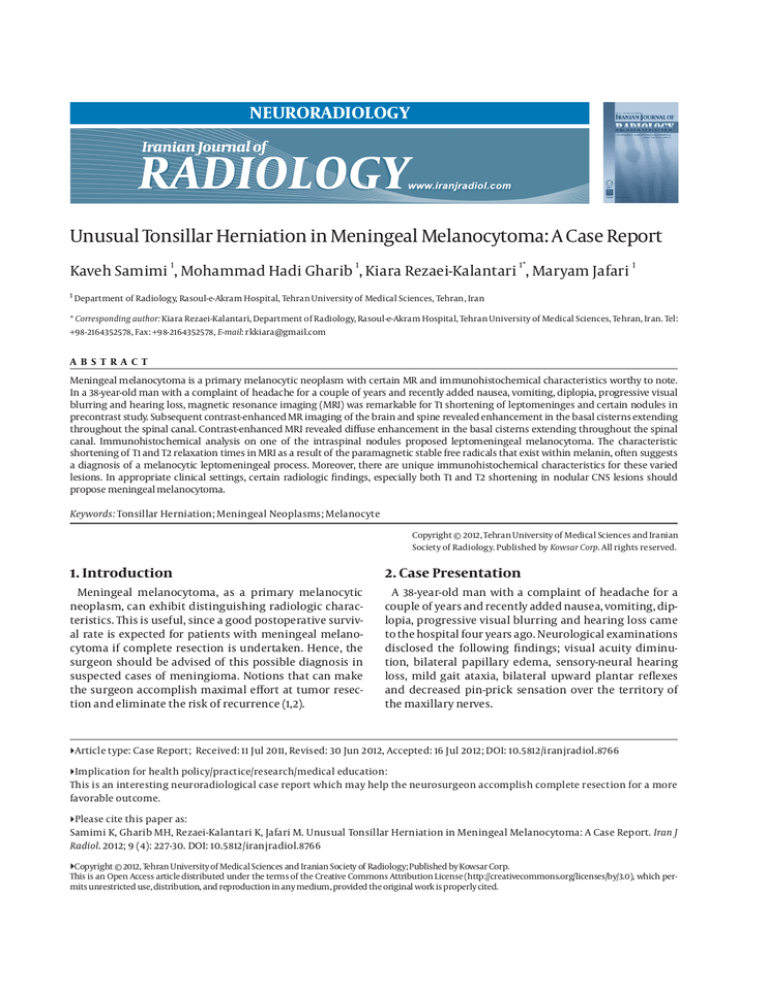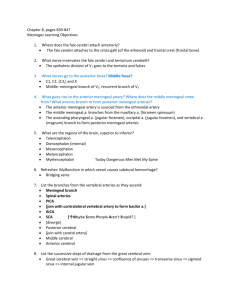
NEURORADIOLOGY
Iranian Journal of
RADIOLOGY
www.iranjradiol.com
Unusual Tonsillar Herniation in Meningeal Melanocytoma: A Case Report
1
1
1*
Kaveh Samimi , Mohammad Hadi Gharib , Kiara Rezaei-Kalantari , Maryam Jafari
1
1 Department of Radiology, Rasoul-e-Akram Hospital, Tehran University of Medical Sciences, Tehran, Iran
* Corresponding author: Kiara Rezaei-Kalantari, Department of Radiology, Rasoul-e-Akram Hospital, Tehran University of Medical Sciences, Tehran, Iran. Tel:
+98-2164352578, Fax: +98-2164352578, E-mail: rkkiara@gmail.com
A B S T R A C T
Meningeal melanocytoma is a primary melanocytic neoplasm with certain MR and immunohistochemical characteristics worthy to note.
In a 38-year-old man with a complaint of headache for a couple of years and recently added nausea, vomiting, diplopia, progressive visual
blurring and hearing loss, magnetic resonance imaging (MRI) was remarkable for T1 shortening of leptomeninges and certain nodules in
precontrast study. Subsequent contrast-enhanced MR imaging of the brain and spine revealed enhancement in the basal cisterns extending
throughout the spinal canal. Contrast-enhanced MRI revealed diffuse enhancement in the basal cisterns extending throughout the spinal
canal. Immunohistochemical analysis on one of the intraspinal nodules proposed leptomeningeal melanocytoma. The characteristic
shortening of T1 and T2 relaxation times in MRI as a result of the paramagnetic stable free radicals that exist within melanin, often suggests
a diagnosis of a melanocytic leptomeningeal process. Moreover, there are unique immunohistochemical characteristics for these varied
lesions. In appropriate clinical settings, certain radiologic findings, especially both T1 and T2 shortening in nodular CNS lesions should
propose meningeal melanocytoma.
Keywords: Tonsillar Herniation; Meningeal Neoplasms; Melanocyte
Copyright © 2012, Tehran University of Medical Sciences and Iranian
Society of Radiology. Published by Kowsar Corp. All rights reserved.
1. Introduction
2. Case Presentation
Meningeal melanocytoma, as a primary melanocytic
neoplasm, can exhibit distinguishing radiologic characteristics. This is useful, since a good postoperative survival rate is expected for patients with meningeal melanocytoma if complete resection is undertaken. Hence, the
surgeon should be advised of this possible diagnosis in
suspected cases of meningioma. Notions that can make
the surgeon accomplish maximal effort at tumor resection and eliminate the risk of recurrence (1,2).
A 38-year-old man with a complaint of headache for a
couple of years and recently added nausea, vomiting, diplopia, progressive visual blurring and hearing loss came
to the hospital four years ago. Neurological examinations
disclosed the following findings; visual acuity diminution, bilateral papillary edema, sensory-neural hearing
loss, mild gait ataxia, bilateral upward plantar reflexes
and decreased pin-prick sensation over the territory of
the maxillary nerves.
Article type: Case Report; Received: 11 Jul 2011, Revised: 30 Jun 2012, Accepted: 16 Jul 2012; DOI: 10.5812/iranjradiol.8766
Implication for health policy/practice/research/medical education:
This is an interesting neuroradiological case report which may help the neurosurgeon accomplish complete resection for a more
favorable outcome.
Please cite this paper as:
Samimi K, Gharib MH, Rezaei-Kalantari K, Jafari M. Unusual Tonsillar Herniation in Meningeal Melanocytoma: A Case Report. Iran J
Radiol. 2012; 9 (4): 227-30. DOI: 10.5812/iranjradiol.8766
Copyright © 2012, Tehran University of Medical Sciences and Iranian Society of Radiology; Published by Kowsar Corp.
This is an Open Access article distributed under the terms of the Creative Commons Attribution License (http://creativecommons.org/licenses/by/3.0), which permits unrestricted use, distribution, and reproduction in any medium, provided the original work is properly cited.
Samimi K et al.
Noncontrast head CT scan showed hyperattenuated foci
in both temporal and occipital lobes, basal meninges and
the cerebellum (Figure 1). Meanwhile, diffuse leptomeningeal enhancement and multiple well-enhanced nodules
along basal cisterns and posterior fossa surface were
noted in contrast-enhanced CT scan. Magnetic resonance
imaging (MRI) was remarkable for T1 shortening of the
leptomeninges and corresponding nodules in precontrast study (Figure 2). Subsequent contrast-enhanced MR
imaging of the brain and spine revealed enhancement in
the basal cisterns extending throughout the spinal canal
(Figure 3). One of the symptomatic intraspinal nodules
was resected and surgical specimens consisting of several leptomeningeal- based fragments of soft brown tissue were submitted for pathological study. Gross features
were not characteristic for any particular type of meningeal tumor. Light microscopic examination showed the
appearance of a neoplastic pigmented lesion. Eventually,
immunohistochemical analysis was reactive for S-100
protein, HMB-45 and vimentin, proposing leptomeningeal melanocytoma.
Because of progression of symptoms and development
of hydrocephalus, the patient underwent a programmable VP shunt one year later, but thereafter, the patient’s
complaints were still present. Further imaging examinations revealed aggravated brain and spinal lesions
and a new onset tonsillar herniation (Figure 4). Thus, an
elective posterior craniotomy for exploration, microdissection, biopsy taking and partial tumor debulking was
undertaken. The patient was discharged with stable and
acceptable general condition. Serial follow up visits were
planned for the patient; however, unfortunately, corresponding medical records were not available at the time
of writing this article.
Tonsillar Herniation in Meningeal Melanocytoma
Figure 2. A, Mid-sagittal T1-weighted image through the cervical and
upper thoracic region is remarkable for hypersignal leptomeningeal lesions of melanocytoma as a result of T1 shortening effect of their melanin
content; B, Mid-sagittal contrast enhanced T1-weighted image is brought
in the corresponding level, revealing contrast enhancement in the aforementioned lesions.
3. Discussion
Figure 1. Noncontrast head CT scan is remarkable for hyperattenuated
foci in basal meninges and cerebellum.
228
Primary melanocytic neoplasms are rare lesions which
originate from normally existing leptomeningeal melanocytes (3). Melanocytes arise from neural crest elements and
are found within the basal layer of the epidermis and the
leptomeninges that cover the base of brain and the brain
stem (4). Moreover, the highest concentration of melanocytes is seen ventrolateral to the medulla oblongata and
upper cervical levels of spinal leptomeniges (5,6). In general, three main types are considered for these neoplasms,
including diffuse melanosis, meningeal melanocytoma
and primary malignant melanoma (7). Nowadays, with
improvements in neuroimaging and clarification of histological features, meningeal melanocytomas are being diagnosed with increased frequency.
Iran J Radiol. 2012:9(4)
Tonsillar Herniation in Meningeal Melanocytoma
Figure 3. A and B, Axial brain contrast enhanced T1-weighted magnetic
resonance images demonstrate nodular and diffuse enhancing regions
of leptomeninges throughout basal cisterns and sulci in the interhemispheric fissure, in the location of presumed melanocytoma lesions.
Samimi K et al.
Clinical presentation of patients with these tumors typically occurs in their fifth decade. It is seen in women twice
as often as men (5). Unlike diffuse melanosis, it is not associated with skin pigmentation. Neurological and clinical
features in meningeal melanocytoma is so varied, including the frequent occurrence of hydrocephalus, seizures,
chronic basal meningitis, multiple cranial nerve palsies,
psychiatric disturbances, intracranial hemorrhage of the
meninges or subdural space and myeloradiculopathy. An
important consideration is that intracranial and spinal
melanocytomas have propensity to arise in proximity to
cranial and spinal nerves as they exit the brainstem and
spinal cord (7-9).
Biological behavior is variable; incomplete resection may
yield in recurrence, an event that may occur because of
extensive leptomeningeal involvement or persistence of
neglected small foci of tumor. Some believe transition into
malignant melanoma does not occur, however, we encountered to four cases of malignant transformation of meningeal melanocytoma, in the literature (10-13). We did not find
any description for a case of melanocytoma with tonsillar
hernaition; however, we presume that in a case with extensive meningeal involvement, an obstacle for complete debulking may increase the mass effect of the growing lesions
consequently leading to this inevitable outcome. Generally, a good postoperative survival rate is expected for patients with meningeal melanocytoma. Hence, the surgeon
should be advised of this possible diagnosis in suspected
cases of meningioma, especially those involving the posterior fossa or Meckel’s cave, information that makes the surgeon accomplish maximal effort at tumor resection. However, preoperative diagnosis of meningeal melanocytoma
is not invariably easy (7).
Figure 4. A, Brain mid-sagittal contrast enhanced T1-weighted image clearly depicts leptomeningeal lesions in the posterior fossa and resultant downward tonsillar herniation; B, Similar diffuse enhancing leptomeningeal lesions are notable in contrast enhanced T1 mid sagittal image through the cervical and upper thoracic spine. Tonsillar herniation is also visible in the top of this image. (C) Sagittal T2-weighted image through cervical and upper
thoracic spine better delineates tonsillar herniation.
Fortunately, the characteristic shortening of T1 and T2 relaxation times in MR imaging , as a result of the paramagnetic stable free radicals that exist within melanin, may
often suggest a diagnosis of a melanocytic leptomenIran J Radiol. 2012:9(4)
ingeal process (7,11). In addition, there is unique ultrastructural and immunohistochemical characteristics for
these varied lesions (7). Another important hint is that
the degree of melanization makes the imaging appear229
Samimi K et al.
ance of meningeal melanocytoma variable. Iso- to hyperattenuating lesions with variable contrast enhancement
is detected in CT images. While, in MR images, these lesions generally show high signal intensity on T1-weighted images, diminished signal on T2-weighted images
and diffuse enhancement after contrast administration
(7,12). Here, an indispensible role is considered for immunohistochemical analysis, a study that can eventually
make differentiation of meningeal melanocytoma from
other similar pigmented lesions possible. Characteristic
immunohistochemical reaction of meningeal melanocytoma is a positive response to antimelanoma (HMB-45),
S-100 protein and vimentin (an indicator of cells with
mesenchymal origin, which rarely appears in malignant
melanoma) antibodies and a negative reaction to epithelial membrane antigen (EMA) (indicator of meningioma)
and Leu7 (indicator of schwannoma) (7,13).
4. Conclusion
In appropriate clinical settings, certain radiological
findings, especially both T1 and T2 shortening in nodular
CNS lesions should propose meningeal melanocytoma
in the mind; a primary melanocytic neoplasm in which
complete resection heralds a favorable prognosis.
Acknowledgements
None declared.
Authors’ Contribution
All authors have worked equally.
Financial Disclosure
None declared.
230
Tonsillar Herniation in Meningeal Melanocytoma
Funding/Support
None declared.
References
1.
2.
3.
4.
5.
6.
7.
8.
9.
10.
11.
12.
13.
Jellinger K, Bock F, Brenner H. Meningeal melanocytoma. Report of a case and review of the literature. Acta Neurochir (Wien).
1988;94(1-2):78-87.
Demir MK, Aker FV, Akinci O, Ozgultekin A. Case 134: primary leptomeningeal melanomatosis. Radiology. 2008;247(3):905-9.
Vanzieleghem BD, Lemmerling MM, Van Coster RN. Neurocutaneous melanosis presenting with intracranial amelanotic melanoma. AJNR Am J Neuroradiol. 1999;20(3):457-60.
Faillace WJ, Okawara SH, McDonald JV. Neurocutaneous melanosis with extensive intracerebral and spinal cord involvement.
Report of two cases. J Neurosurg. 1984;61(4):782-5.
Clarke DB, Leblanc R, Bertrand G, Quartey GR, Snipes GJ. Meningeal melanocytoma. Report of a case and a historical comparison. J Neurosurg. 1998;88(1):116-21.
Tatagiba M, Boker DK, Brandis A, Samii M, Ostertag H, Babu R.
Meningeal melanocytoma of the C8 nerve root: case report. Neurosurgery. 1992;31(5):958-61.
Painter TJ, Chaljub G, Sethi R, Singh H, Gelman B. Intracranial
and intraspinal meningeal melanocytosis. AJNR Am J Neuroradiol.
2000;21(7):1349-53.
Fox H, Emery JL, Goodbody RA, Yates PO. Neuro-Cutaneous Melanosis. Arch Dis Child. 1964;39:508-16.
Ruelle A, Tunesi G, Andrioli G. Spinal meningeal melanocytoma.
Case report and analysis of diagnostic criteria. Neurosurg Rev.
1996;19(1):39-42.
Wang F, Li X, Chen L, Pu X. Malignant transformation of spinal
meningeal melanocytoma. Case report and review of the literature. J Neurosurg Spine. 2007;6(5):451-4.
Rades D, Tatagiba M, Brandis A, Dubben HH, Karstens JH. [The value of radiotherapy in treatment of meningeal melanocytoma].
Strahlenther Onkol. 2002;178(6):336-42.
Roser F, Nakamura M, Brandis A, Hans V, Vorkapic P, Samii M.
Transition from meningeal melanocytoma to primary cerebral
melanoma. Case report. J Neurosurg. 2004;101(3):528-31.
Uozumi Y, Kawano T, Kawaguchi T, Kaneko Y, Ooasa T, Ogasawara
S, et al. Malignant transformation of meningeal melanocytoma:
a case report. Brain Tumor Pathol. 2003;20(1):21-5.
Iran J Radiol. 2012:9(4)



